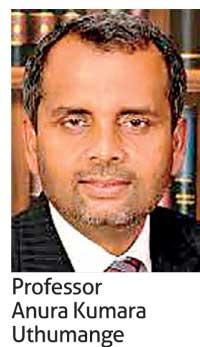27 May 2022 - {{hitsCtrl.values.hits}}
Taking a swipe at the current policies instituted to tackle inflation and Sri Lanka’s external sector woes, a Professor of Business Economics opined that orthodox economics cannot resolve the problems facedby the economy at present as one must take a closer look at what caused inflation and Balance of Payment (BoP) troubles.
 Pushing back on the consensus view held by mainstream economists, Professor Anura Kumara Uthumange of the University of Sri Jayewardenapura told a recent debate that the current bout of record high inflation is more of a supply side issue than a demand side problem, and the external sector crunch is caused by the loss of dollar inflows in the two years of the pandemic.
Pushing back on the consensus view held by mainstream economists, Professor Anura Kumara Uthumange of the University of Sri Jayewardenapura told a recent debate that the current bout of record high inflation is more of a supply side issue than a demand side problem, and the external sector crunch is caused by the loss of dollar inflows in the two years of the pandemic.
Hence, he said the current red hot inflation, barring the one-off effects coming from rupee float and the administered price adjustments cannot be tamped down by conventional tools like raising interest rates as higher prices is the result of disruptions to supply chains and slowdown in production.
“The problem we face at present is the decline in supply in the country. The main reason for the hotter prices is the lack of dollars in the country and the lack of sufficient production,” Professor Uthumange said.
“If production increases, we can solve this problem. If we get dollars, we can solve this issue. Everyone must understand the true reason behind what caused higher inflation. If we try to solve the inflation and dollar shortage by instituting orthodox policies, without trying to understand the true causes of what caused higher prices, it could lead to so many unintended anomalies,” he told a recent TV debate.
The current Central Bank Governor Dr. Nandalal Weerasinghe in a change of language from a month ago acknowledged last week that the current inflation, barring the rupee float effects, cannot be tempered by raising interest rates as it is supply driven rather than demand pushed.
Sri Lankans didn’t enter an economic hard landing in March as a result of lavish spending on stuff leading up to it, but due to supply squeeze caused by the dollar shortage precipitated by the global commodities price inflation, supply chain disruptions, and the Russia’s invasion of Ukraine on February 24 which further pushed global energy and other prices through the roof.
But, the authorities are equally or more at fault for taking all the wrong economic policy decisions and constantly lying to the public and doing nothing to minimise the impact on households and businesses.
The then Central Bank Governor Cabraal shrugged off concerns continuously raised on the economy’s health by various parties but never took preemptive measures to contain the crisis. Instead he threw people from frying pan to the fire by badly executing the rupee float on March 7, sending the country into hyperinflation and many millions below poverty line.
Speaking further Professor Uthumange said cutting imports won’t solve the BoP nor the inflation issues, instead would aggravate the conditions as curtailing imports would have a knock on effect on exports and would have a chain reaction through the micro, small and medium-sized enterprises.
“Our consumption imports are only 14 percent of the total imports, but the bulk is intermediate and investment goods. And if the latter two stops, it will deal a lethal blow to our production industries and export industries,” he explained.
Hence, he said the country must reduce the interest rates and bring down the dollar/rupee exchange rate back to where it was in order to prop production and ensure that our exports remain competitive in the global marketplace.
A significantly weaker rupee against the dollar makes the input costs of exports expensive and thereby makes them uncompetitive in the global market.
09 Nov 2024 1 hours ago
09 Nov 2024 3 hours ago
09 Nov 2024 5 hours ago
09 Nov 2024 6 hours ago
09 Nov 2024 7 hours ago